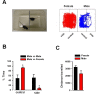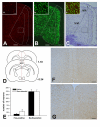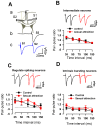Sexual attraction enhances glutamate transmission in mammalian anterior cingulate cortex
- PMID: 19419552
- PMCID: PMC2685783
- DOI: 10.1186/1756-6606-2-9
Sexual attraction enhances glutamate transmission in mammalian anterior cingulate cortex
Abstract
Functional human brain imaging studies have indicated the essential role of cortical regions, such as the anterior cingulate cortex (ACC), in romantic love and sex. However, the neurobiological basis of how the ACC neurons are activated and engaged in sexual attraction remains unknown. Using transgenic mice in which the expression of green fluorescent protein (GFP) is controlled by the promoter of the activity-dependent gene c-fos, we found that ACC pyramidal neurons are activated by sexual attraction. The presynaptic glutamate release to the activated neurons is increased and pharmacological inhibition of neuronal activities in the ACC reduced the interest of male mice to female mice. Our results present direct evidence of the critical role of the ACC in sexual attraction, and long-term increases in glutamate mediated excitatory transmission may contribute to sexual attraction between male and female mice.
Figures









Similar articles
-
Characterization of excitatory synaptic transmission in the anterior cingulate cortex of adult tree shrew.Mol Brain. 2017 Dec 18;10(1):58. doi: 10.1186/s13041-017-0336-5. Mol Brain. 2017. PMID: 29249203 Free PMC article.
-
Synaptic organization and input-specific short-term plasticity in anterior cingulate cortical neurons with intact thalamic inputs.Eur J Neurosci. 2007 May;25(9):2847-61. doi: 10.1111/j.1460-9568.2007.05485.x. Eur J Neurosci. 2007. PMID: 17561847
-
Multiple synaptic connections into a single cortical pyramidal cell or interneuron in the anterior cingulate cortex of adult mice.Mol Brain. 2021 Jun 3;14(1):88. doi: 10.1186/s13041-021-00793-8. Mol Brain. 2021. PMID: 34082805 Free PMC article.
-
Kainate receptor-mediated synaptic transmission in the adult anterior cingulate cortex.J Neurophysiol. 2005 Sep;94(3):1805-13. doi: 10.1152/jn.00091.2005. Epub 2005 May 31. J Neurophysiol. 2005. PMID: 15928066
-
Short-term synaptic plasticity in the nociceptive thalamic-anterior cingulate pathway.Mol Pain. 2009 Sep 4;5:51. doi: 10.1186/1744-8069-5-51. Mol Pain. 2009. PMID: 19732417 Free PMC article. Review.
Cited by
-
Medial prefrontal cortex neuronal activation and synaptic alterations after stress-induced reinstatement of palatable food seeking: a study using c-fos-GFP transgenic female rats.J Neurosci. 2012 Jun 20;32(25):8480-90. doi: 10.1523/JNEUROSCI.5895-11.2012. J Neurosci. 2012. PMID: 22723688 Free PMC article.
-
Characterization of the anterior cingulate cortex in adult tree shrew.Mol Pain. 2016 Jan-Dec;12:1744806916684515. doi: 10.1177/1744806916684515. Mol Pain. 2016. PMID: 28256938 Free PMC article.
-
Calcium/calmodulin-dependent kinase IV contributes to translation-dependent early synaptic potentiation in the anterior cingulate cortex of adult mice.Mol Brain. 2010 Sep 16;3:27. doi: 10.1186/1756-6606-3-27. Mol Brain. 2010. PMID: 20846411 Free PMC article.
-
Sex-dependent alterations in the physiology of entorhinal cortex neurons in old heterozygous 3xTg-AD mice.Biol Sex Differ. 2020 Nov 16;11(1):63. doi: 10.1186/s13293-020-00337-0. Biol Sex Differ. 2020. PMID: 33198813 Free PMC article.
-
Pharmacogenetics of glutamate system genes and SSRI-associated sexual dysfunction.Psychiatry Res. 2012 Aug 30;199(1):74-6. doi: 10.1016/j.psychres.2012.03.048. Epub 2012 Apr 24. Psychiatry Res. 2012. PMID: 22534499 Free PMC article.
References
Publication types
MeSH terms
Substances
Grants and funding
LinkOut - more resources
Full Text Sources

